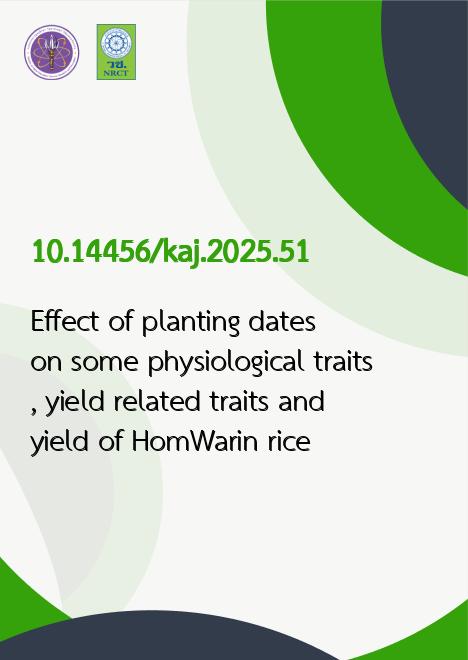
|
Effect of planting dates on some physiological traits, yield related traits and yield of HomWarin rice |
|---|---|
| รหัสดีโอไอ | |
| Creator | Sureeporn Katengam |
| Title | Effect of planting dates on some physiological traits, yield related traits and yield of HomWarin rice |
| Contributor | Anuson Thanasi, Nopamas Namdang, Chantamart Chueakaew |
| Publisher | Faculty of Agriculture |
| Publication Year | 2568 |
| Journal Title | Khon Kaen Agriculture Journal |
| Journal Vol. | 53 |
| Journal No. | 4 |
| Page no. | 719-732 |
| Keyword | photo-sensitive rice, HomWarin, planting date, physiological traits, yield |
| URL Website | https://li01.tci-thaijo.org/index.php/agkasetkaj |
| Website title | Khon Kaen Agriculture Journal |
| ISSN | 3027-6497 (Online) |
| Abstract | The planting date of photo-sensitive rice is a key agronomic practice that significantly influences its growth and yield. This study aimed to evaluate the impact of different planting dates on the physiological traits, yield-related characteristics, and overall yield of HomWarin rice variety. A randomized complete block design with three replications was used for the experiment during the wet season of 2021. Five planting or transplanting dates were tested: July 1 (PD1), July 15 (PD2), August 1 (PD3), August 15 (PD4), and August 29 (PD5). Results indicated that the planting date notably affected various physiological characteristics and yield-related traits. Planting on July 15 (PD2) resulted in the highest grain yield for HomWarin. Correlation analysis revealed that plant height and aboveground biomass were positively correlated with grain yield. Additionally, stepwise regression analysis identified the length of the photoperiod as a critical climatic factor, with harvest index (HI), number of panicles per plant (NPP), number of spikelets per panicle (NSP), 1,000 grains weight (TGW), and aboveground biomass (BM) as significant contributors to yield variation. These findings suggest that the optimal planting date for HomWarin rice, a weak photo-sensitive variety, is July 15, resulting in the highest yield. This study provides valuable insights for adjusting rice transplanting dates in response to changing climatic conditions, optimizing agronomic management for photo-sensitive rice varieties. |